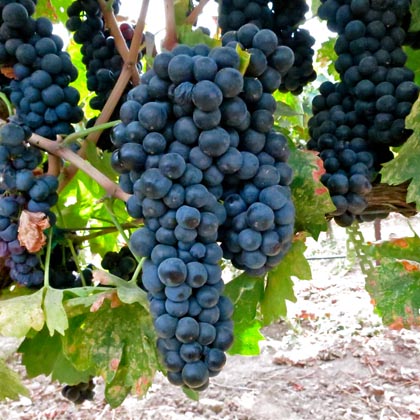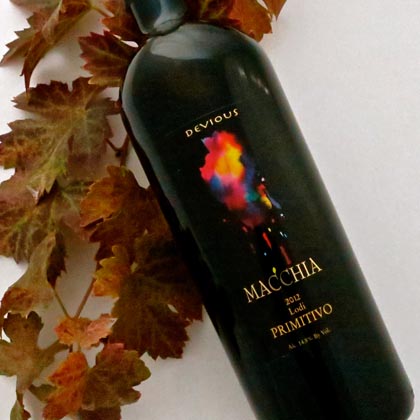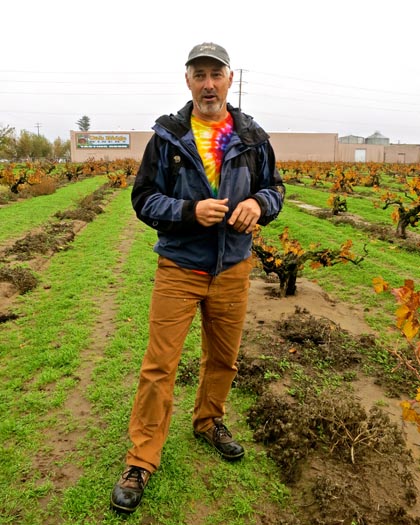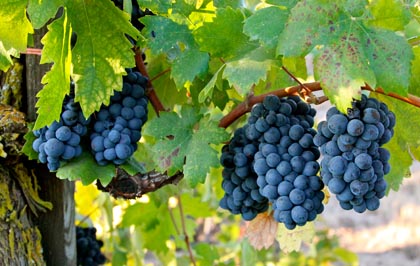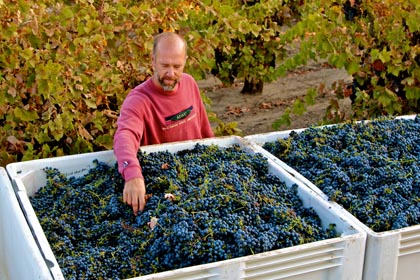Letters from Lodi
An insightful and objective look at viticulture and winemaking from the Lodi
Appellation and the growers and vintners behind these crafts. Told from the
perspective of multi-award winning wine journalist, Randy Caparoso.
The new Macchia Primitivo — the milder, smoother identical twin of Zinfandel
Maley Vineyards Primitivo in 2013: note long clusters and uniform sized berries
Macchia Wines, which produces more single-vineyard Zinfandels than any other winery in Lodi, has just released their first-ever bottling of Primitivo: the 2012 Macchia Lodi Primitivo ($24) – a full bodied yet smooth, mildly tart edged red wine that has something of an "Italian" feel in its bright, upbeat, drink-me-with-food qualities. But like a good Zinfandel, this Primitivo is teeming with sun kissed berryish fruit; tinged with sweet peppercorn spice, and subtle touches of cedarwood-ish oak.
Macchia Lodi Primitivo
Macchia winemaker/owner Tim Holdener tells us, "This is our inaugural experience with Primitivo. Ours is grown by Todd Maley, at his vineyard on Davis Rd. just north of Bare Ranch. We're still learning about the grape – how it grows, and what winemaking practices to apply. But so far I would describe it as something that is very similar to our Zinfandels. In fact, it is a Zinfandel – only milder, a little smoother and easier to drink, and maybe a little earthier in its fruit expression."
How can Primitivo be different from Zinfandel, as Holdener tells us, while exactly the same thing? Primitivo, in fact, is a clonal variation of Zinfandel: a different grape; yet biologically, technically, and legally (Primitivo can be bottled as Zinfandel, and vice-versa), the same grape. Like an identical twin – sharing the same DNA – with a different personality.
Holdener adds, "Out in the fields Primitivo is like Zinfandel, growing good sized clusters of really dark fruit. You almost expect to make some really big, dark wines from it, but that's not the case. What you get instead are wines that are little more normal in alcohol, closer to 14%; unlike Zinfandel, which is usually higher than 15%. This is great because it gives us a chance to make a more balanced, elegant, almost 'European' style of wine. As you know, I'm a big fan of big Zinfandels, but with Primitivo we can make something a little different, as an alternative to Zinfandel."
The Zinfandel grape as we know it first began to be planted throughout California in the 1850s, in lock step with many of the pioneers originally drawn in by the Gold Rush. There were numerous varieties of wine grapes available to these prospective grape growers, but Zinfandel emerged as the nineteenth century favorite because of the apparent ease in which it could be cultivated in California's Mediterranean climate; and no doubt, because of the quality of red wine that could be made from the grape.
Macchia’s Tim Holdener among old vine Zinfandel in Noma Ranch
All varieties of wine grapes invariably exhibit slightly different morphologies when grown in different places, and cultivated in different ways. But by and large, Zinfandel produces medium to large clusters with berries of relatively thin skin (in comparison to thicker skinned red wine grapes, such as Cabernet Sauvignon, Tannat or Touriga Nacional).
Other black skinned grapes with thin skins, such as Pinot Noir, tend to produce smooth red wines with soft tannins; whereas bigger, high tannin red wines are associated with thick skinned grapes. Yet, as everyone knows, many Zinfandels can be soft and easy drinking, and many others quite big, high in tannin, and mouth filling. This is because of Zinfandel's unique tendency to grow clusters with uneven sized berries: on one bunch, berries plump with pulp, in amongst smaller, beadier, sometimes raisined berries. Smaller sized berries have higher skin to juice ratios; resulting in increased pigmentation, tannin, acid and sugar content, as well as the attractively "jammy" flavor, commonly associated with deeper, heavier, more concentrated styles of Zinfandel, which typically finish with as much as 15%, 16% alcohol.
Primitivo, on the other hand, is a Zinfandel clone that was brought into California from the Apulia region in Southern Italy fairly recently: it was not widely distributed to West Coast growers until the 1990s. Cuttings of Primitivo were first brought in from Italy by researchers at U.C. Davis in 1968, and conclusively identified as being identical to Zinfandel in 1972 – a finding later (in 1993) confirmed by DNA analysis.
Which is not to say that Primitivo originated in Southern Italy. In fact, research also shows that both variants, Primitivo and Zinfandel, originally came out of Croatia, located across the Adriatic Sea from Italy; and most likely, Primitivo did not make it over to Puglia until the 1870s. Insofar as Zinfandel getting all the way from Croatia to California – some time between 1829 and 1850 – that exact route is still shrouded in a little bit of mystery.
In terms of vine and cluster morphology, there are differences between Zinfandel and Primitivo, accounting for why Lodi growers such as Mettler & Son (Harney Lane Winery's growing operation), Maley, and Bokisch Ranches have been seriously cultivating Primitivo in addition to Zinfandel. Primitivo vines tend to grow longer, looser clusters; thus making the grape's thin skin less susceptible to mold or rot – a perennial problem for Zinfandel growers. Primitivo's berry sizes also tend to be more uniform – in most years, having less of the "hens-and-chicks" cluster morphology that is one of the hallmarks, or drawbacks (depending upon how you look at it), of classic Zinfandel.
Classic Zinfandel in Lizzy James Vineyard: note compact clusters and slightly uneven sized berries (although not as prominent in 2013)
Consequently, red wines bottled as Primitivo in California tend to be lush and juicy in berry flavors like classic Zinfandel; but typically, softer, more consistent in texture, lower in average alcohol (less likely to exceed 15%), and with less of the peppery, sometimes clove-like spice found in more intense Zinfandels. In other words, not quite as wild, crazy or interesting – unless you prefer “mild” and “demure.” The “good” twin — not the one with the goat’s head tatoos, pierced body parts and attitude.
Besides Macchia, other wineries that have been bottling first-rate Lodi grown varietal Primitivo include Sorelle, Uvaggio, and Harney Lane (the latter's, sold only at the winery). The Napa Valley based Neyers Vineyards produces a silky, sexy "Vista Luna Zinfandel" that is actually a 100% Primitivo grown by Bokisch Ranches in Lodi's Borden Ranch AVA. Harney Lane's Lodi Zinfandel bottlings, in fact, consist of at least 50% Primitivo each vintage – testifying to the compellingly lush qualities that this grape is capable of producing.
As Mr. Holdener tells us, "If you are a Zinfandel drinker who loves purer fruit expression, you'll love Primitivo."
Todd Maley with his Weget Vineyard Zinfandel
